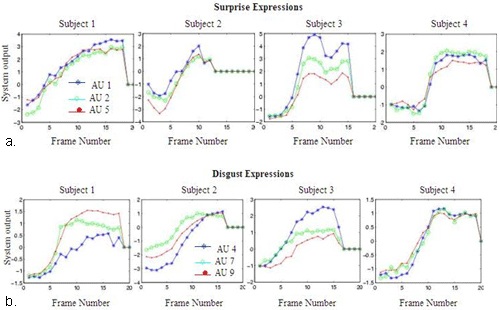 |
|
Auto FACS Coding
Fully automated facial action coding The output of the face detector is fed directly to the facial expression analysis system (see Figure 1). First the face image is passed through a bank of Gabor filters at 8 orientations and 9 scales (2-32 pixels/cycle at 0.5 octave steps). The filterbank representations are then channeled to a statistical classifier to code the image in terms of a set of expression dimensions. We conducted a comparison of classifiers, including support vector machines (SVM’s), Adaboost (Freund & Shapire, 1996), and Linear Discriminant Analysis (Littlewort et al., in press, Bartlett et al., 2003). SVM’s were found to be very effective for classifying facial expressions. Recent research at our lab has demonstrated that both speed and accuracy are enhanced by performing feature selection on the Gabor filters prior to classification (e.g. Bartlett et al., 2003). This approach employs Adaboost for feature selection prior to classification by SVM’s. Adaboost sequentially selects the feature that gives the most information about classification given the features that have been already selected. Adaboost was more effective than other feature selection techniques such as PCA.
a. Results on the DFAT-504 dataset Seven support vector machines, one for each AU, were trained to detect the presence of a given AU, regardless of whether it occurred alone or in combination with other AU’s. The expression recognition system was trained on the last frame of each sequence, which contained the highest magnitude of the target expression (AU peak). Negative examples consisted of all peak frames that did not contain the target AU, plus 313 neutral images consisting of the first frame of each sequence. A nonlinear radial basis function kernel was employed. Generalization to new subjects was tested using leave-one-out cross-validation (Tukey, 1951). The results are shown in Table 1.
System outputs for full image sequences are shown in Figure 2. These are results for test image sequences, which are sequences not used for training.
The system obtained a mean of 93.6% agreement with human FACS labels for fully automatic recognition of 18 upper facial actions. This is an exciting result, as performance rates are equal to or better than other systems tested on this dataset that employed manual registration. (Tian, Kanade & Cohn, 2001; Kapoor, Qi, & Picard, 2003). Kapoor et al. obtained 81.2% correct on this dataset, using hand marked pupil positions for alignment. Tian et al. obtained a similar level of performance to ours, but hand-marked a set of feature points in neutral expression images immediately preceding each movement. The high performance rate obtained by our system is the result of many years of systematic comparisons investigating which image features (representations) are most effective (Bartlett et al., 1999, Donato et al., 1999), which classifiers are most effective (Littlewort et al., 2004), optimal resolution and spatial frequency (Donato et al., 1999; Littlewort et al., submitted), feature selection techniques (Littlewort et al., submitted), and comparing flow-based to texture-based recognition (Bartlett et al., 1999, Donato et al., 1999).
b. Preliminary results on the RU-FACS-1 dataset. We are presently testing fully automatic FACS recognition in the continuous video stream. Faces images were automatically detected. Alignment in the 2D plane was then refined using automatically detected eye locations. The resulting images were then ported to the AU detectors trained on the DFAT-504 database. The figure below shows example system outputs for a video sequence that contains an AU 1 and AU 2. Preliminary results based on 1 subject show a mean agreement rate of 88.7% between the automated system and the human FACS codes for the four actions with sufficient data to test (AU’s 1, 2, 6, and 7). (Results by action are AU 1, 87.3% for AU2, 92.4% for AU 6, and 86.4% for AU 7).Here ‘agreement’ is the percent of frames above or below threshold in accordance with the human codes. In the coming months, we will train AU detectors directly on the spontaneous expression samples from Rutgers as the data becomes available.
|



